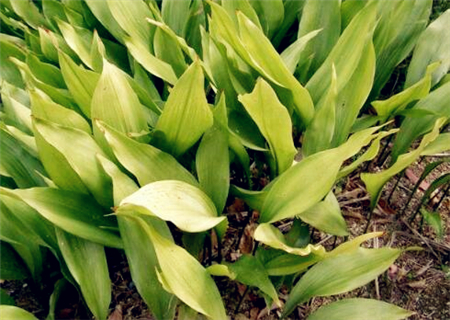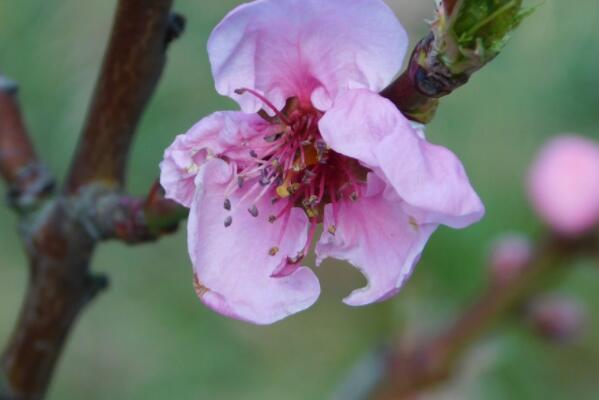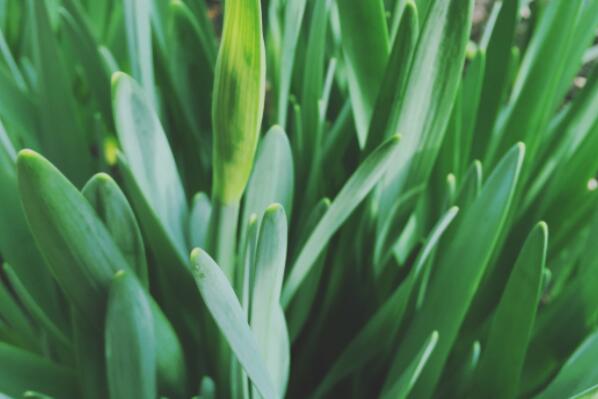When will the one-leaf orchid of Ruo leaf blossom? What if the leaves turn yellow? Culture methods and matters needing attention are attached
One-leaf orchid, also known as spider egg, alias big leaf evergreen, bamboo leaf plate, Kowloon plate, bamboo tendon and so on, for Liliaceae, spider egg genus plant. Traditional Chinese medicine (TCM) is widely used in traditional Chinese medicine with rhizome components. So when will the leaf orchid bloom? What if the leaves turn yellow? Now for you to sort out the cultivation methods and matters needing attention.

When does the leaf orchid blossom
One-leaf orchid blossoms from March to April (in the natural environment), but if the family farming, the temperature change of the four seasons is different from nature, higher than the temperature of the same period, it will generally blossom early. However, the one-leaf orchid raised at home rarely blossoms, which is also related to the environment and cannot be forced.
The floral language of the orchid
The flower language of one-leaf orchid is Tian Chang Di Jiu (Eternal Dumpling), which is unique, so it is often used as one of the gifts given to each other between lovers. Because we want to be unique to each other, and Tian Chang Di Jiu (Eternal Dumpling) is also the best wish to the couple before.
Cultivated varieties of one-leaf orchid
1. Variegated leaf orchid: spotted leaf orchid alias golden spider holding egg, spotted leaf spider holding egg, star spot spider holding egg, is a cultivated variety of one leaf orchid, with milky white or light yellow spots on the green leaf.
2. Golden leaf orchid: Golden leaf orchid alias golden spider holding egg, white spider holding egg, is a cultivated variety of one-leaf orchid, and there are light yellow vertical lines on the green leaves.
Ramet Propagation of Cymbidium chinense
1. Ramet time: the ramet propagation of Cymbidium can be carried out in combination with changing pots before the new buds germinate, usually after the soil is thawed in early spring (February and March).
2. Split method: take the mother plant out of the flowerpot, shake off the excess potted soil, separate the root system as much as possible, and cut it into two or more plants with a sharp knife. Each plant should have a considerable root system, and its leaves should be pruned properly to make each clump with 3 to 5 leaves, in order to survive.
Culture method of one-leaf orchid
1. Load the basin: soak the divided plants in 1500 times chlorothalonil for five minutes, then take out the cold and dry, and then serve. You can also irrigate the root with chlorothalonil immediately after potting.
2. Management: root irrigation or watering once after ramet potting, because the root system is greatly damaged and the ability of water absorption is very weak, it takes about 3-4 weeks to recover new roots, so it is necessary to control watering within 3-4 weeks after ramet to avoid rotting roots, but the transpiration of its leaves is not affected. In order to maintain the water balance of leaves, it is necessary to spray the leaves once or three times a day. Don't fertilize it these days. After ramet, we should also pay attention to the excessive sunlight, it is best to keep it in the shade shed.
3. Upper basin: first put a thick matrix of 2cm thick as a filter layer at the bottom of the basin, and then put in the plant. The substrate for the upper basin can choose one of the following. Peat: perlite: ceramsite = 2:2:1 or peat: vermiculite = 1:1 or peat: slag: ceramsite = 2:2:1 or sawdust: vermiculite: medium coarse river sand = 2:2:1 or vegetable garden soil: slag = 3:1 or garden soil: medium coarse river sand: sawdust = 4:1:2 or paddy soil, pond mud, rotten leaf soil, etc. After putting on the basin, pour water once and keep it in a shaded environment.
Maintenance technology of one-leaf orchid
1. Soil: Magnolia lanceolata is not strict on soil and resistant to barren, but it is better to use loose and fertile slightly acidic sandy loam. When potted, rotten leaf soil, peat soil and garden soil can be mixed in the same amount as substrate.
2. Moisture: the orchid should be fully watered in the growing season, keep the basin soil moist, and often spray water to the leaves to facilitate sprouting and growing new leaves, and the amount of water can be reduced appropriately after the end of autumn.
3. Lighting: one-leaf orchid can be cultivated in bright indoor all the year round, but it can not be placed in direct sunlight, either indoors or outdoors. Short exposure to the sun may also cause leaf burns and reduce ornamental value.
Summary: the breeding method of one-leaf orchid is introduced to you first. In fact, one-leaf orchid is very suitable for home and office layout, it can be watched alone, it can also be arranged with other flowering plants, and it is also a leaf material for modern flower arrangement. interested friends can then take a look at the breeding points for attention!
Matters needing attention in culturing Cymbidium mongolica
1. One-leaf orchid should be fully watered in the growing season, keep the basin soil moist, and often spray water to the leaves, so as to sprout and grow new leaves, and the amount of water can be reduced appropriately after the end of autumn.
2. In addition to controlling temperature and moisture, one-leaf orchid culture should pay special attention to whether it is sick or not, and cut off and burn the diseased leaves in time to reduce the source of infection.
3. Before the onset of the rainy season, spraying 50% Baig or Baogong wettable powder 1000 times, 25% carbon tetralin wettable powder. Once every 10 days, prevention and control 3 times 4 times.
4. Cymbidium is a shade-tolerant plant, the light should not be too strong, otherwise it will cause leaf yellowing or disease. Too much irrigation, especially in winter, can lead to root rot and leaf yellowing.
5. The maintenance of Euphorbia angustifolia in the greenhouse can increase the night temperature of the greenhouse, increase the ventilation time during the day, and reduce the humidity and fog duration in the greenhouse, so as to achieve the purpose of disease control.
6. In the peak growth period of spring and summer, one-leaf orchid is applied once or twice a month to ensure that the leaves are beautiful and bright, and can be cultivated in bright indoor all the year round, but no matter indoors or outdoors, they can not be placed in direct sunlight.
The reason for the yellowing of the leaves of Cymbidium: the light is too strong
A leaf orchid has broad leaves, and the green leaves give people a kind of warmth all the time. This kind of plant is most afraid of bright light. Exposure to the sun for a short time will burn the leaves and affect the ornamental value. If the green leaves in your home become a pile of withered grass after the baptism of the sun at noon, you will die if you are not angry to death.
Solution: one-leaf orchid can be planted in a bright indoor room all the year round, but not in a place where the sun shines directly, especially next to the window.
The second reason for the yellowing of Cymbidium leaves: too little light.
The plant is sometimes so strange that it is difficult to read its mind. No sun, no shade. Although one-leaf orchid is very shady, it can grow for months in a dark environment. But long-term darkness is not conducive to the germination and growth of new leaves, the new leaves are dull and dull, although they will not become withered leaves, but they are not very beautiful.
Solution: a leaf orchid can be placed in a dark environment, but it is best to move it to a bright environment every once in a while to feel the temperature of the sun, which is more conducive to growth and viewing. Especially during the period from the growth of new leaves to maturity, try to keep them in a bright place.
The reason for the yellowing of the leaves of one-leaf orchid
Too little light
A leaf orchid has broad leaves, and the green leaves give people a kind of warmth all the time. This kind of plant is most afraid of bright light. Exposure to the sun for a short time will burn the leaves and affect the ornamental value. If the green leaves in your home become a pile of withered grass after the baptism of the sun at noon, you will die if you are not angry to death.
Solution: one-leaf orchid can be planted in a bright indoor room all the year round, but not in a place where the sun shines directly, especially next to the window.
Too much watering
Overwatering is also one of the reasons for the yellowing of Cymbidium leaves. Cymbidium likes water, but to a certain extent, it will not die even if it is dry for several days, but too much watering will affect root respiration, resulting in yellowing of leaves. Just like a person who can't swim, he is suddenly thrown into the water and will surely wilt when he comes out!
Solution: one-leaf orchid watering should be dry and wet, not too much, but not too little. Sufficient water is needed during the growth period, but there must be no stagnant water.
Fertilization is too thick
The demand for fertilizer is not particularly large, fertilization is best to choose light fertilizer, too much fertilization is easy to cause root burning, destroy the growth of one-leaf orchid, and the leaves will turn yellow because of fertilizer damage.
Solution: fertilization should not be too frequent, apply thin liquid fertilizer once every 15 days to promote the germination and growth of branches and leaves, ensure that the leaves are beautiful and bright, and do not apply too much fertilizer.
Pest infection
Indoor maintenance of a leaf orchid, it is very easy to appear red spiders, red spiders parasitic on the leaves, the absorption of juice will lead to leaf yellowing.
Solution: always look at both sides of the blade and often wipe the blade with clean water to ensure that the blade is clean and bright. Once red spiders are found, triclofenac and Nisolang should be sprayed in time.
Time: 2019-04-10 Click:
- Prev

Why do peach trees ward off evil spirits? Before and after flowering, aphids, heart-eating insects and other pests hit what drugs?
Peach trees are small deciduous trees with narrow oval to lanceolate leaves. They are native to China and are widely cultivated in various provinces. It is planted all over the world. So do you know why peach trees can ward off evil spirits? Before and after flowering, aphids, heart-eating insects and other pests hit what drugs? Let's learn about it together. Why do peach trees ward off evil spirits?
- Next

"intestinal lavage grass" is leek hair product? What kind of medicine do you take when the leaves turn yellow? What is the easiest way to plant?
Leek, alias Fengben, grass stalactite, Qiyang grass, lazybones, Changsheng leek, Zhuangyang grass, flat vegetables, etc., strong adaptability, cold and heat resistance, cultivated all over the country. Is it a hair product? What kind of medicine do you take when the leaves turn yellow? What is the easiest way to plant? It is understood that
Related
- Fuxing push coffee new agricultural production and marketing class: lack of small-scale processing plants
- Jujube rice field leisure farm deep ploughing Yilan for five years to create a space for organic food and play
- Nongyu Farm-A trial of organic papaya for brave women with advanced technology
- Four points for attention in the prevention and control of diseases and insect pests of edible fungi
- How to add nutrient solution to Edible Fungi
- Is there any good way to control edible fungus mites?
- Open Inoculation Technology of Edible Fungi
- Is there any clever way to use fertilizer for edible fungus in winter?
- What agents are used to kill the pathogens of edible fungi in the mushroom shed?
- Rapid drying of Edible Fungi

